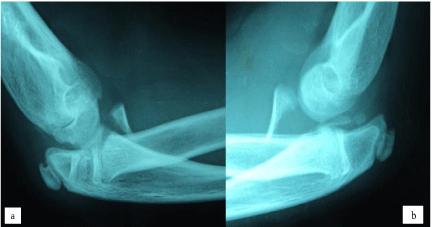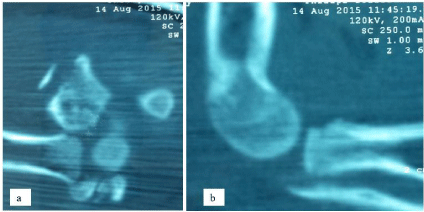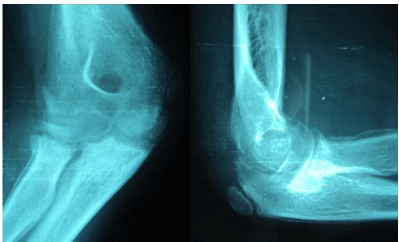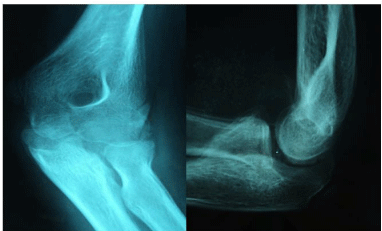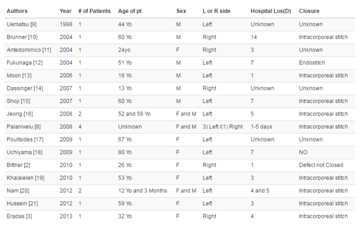Case Report
Bilateral Terrible Triad of Elbow: A Pediatric Case Report
Zied Jlalia*, Hichem Abid, Khaled Kamoun and Mourad Jenzri
Department of Orthopedic pediatric, University of Tunis El Manar, Tunisia
*Corresponding author: Zied Jlalia, Department of Orthopedic pediatric, Kassabinstitute for orthopedic surgery, Ksarsaid 2010 Tunis, Tunisia
Published: 28 Nov, 2016
Cite this article as: Jlalia Z, Abid H, Kamoun K, Jenzri
M. Bilateral Terrible Triad of Elbow: A
Pediatric Case Report. Ann Clin Case
Rep. 2016; 1: 1191.
Abstract
While the majority of terrible triad elbow injuries (elbow dislocation with radial head and coronoid fractures) are managed surgically, nonoperative treatment maybe appropriate in selected patients, but results with this approach have been limited by very small studies. The aim of this article is to show the alternative and benefits of orthopedic treatment of terrible triad elbow injuries in Children.
Keywords: Children; Elbow; Terrible triad
Introduction
The elbow injury represents a common reason for consultation with the child. The most common mechanism is a fall in hyperextension of the upper limb [1]. Dislocation of elbow is less common, but when it is associated with a fracture of the radial head and the coronoid apophysis, it then joins an entity that is seen in adults called terrible triad of the elbow [2]. When the terrible triad is diagnosed in children, treatments are they always the same as in adults?
Case Presentation
A 13 year-old boy presented to our emergency room with a bilateral elbow trauma after a fall from height of 3 meters. X-rays of face and profile of 2 elbows revealed a dislocation of the elbows with additional fractures of the radial head, and coronoid process (Figure 1). No vascular and nerve complications were noted. Other complementary examinations have not revealed additional trauma. We executed a closed manipulation of the elbow under sedation in the operation room; a steady reduction in the elbow could be obtained. We applied a long arm cast and post manipulation neurovascular examination was normal. A CT Scan of 2 elbows was realized. The CT-Scan showed a reduction of two elbows joints, as well as the comminuted fractures of the 2 radial heads with intraarticular fragments and multifragment fractures of the coronoid process in both elbows (Figure 2).
Figure 1
Figure 1
Lateral radiography of both elbows, who showed terrible tirade of
right and left elbows (a- right elbow, b- left elbow).
Figure 2
Figure 2
The CT-Scan of comminuted fractures of the 2 radial heads with
intra-articular fragments (a- right elbow, b- Left elbow).
Figure 3
Figure 3
Front and lateral radiography of right elbow 6 month after trauma
who showed fracture healing and a good remodeling of the radial head.
Figure 4
Figure 4
Front and lateral radiography of the left elbow 6 month after trauma,
good remodeling of the radial head fracture and coronoid process fracture.
Table 1
Discussion
The terrible triad of the elbow is a severe injury that is difficult to treat and has a poor prognosis in the medium to long term. This lesion recently described by Hotchkiss and al, 3 lesions: Elbow dislocation with radial head and coronoid process fracture, these injuries are not frequent even in adults [3]. In child this lesion presents some particularities related with the properties of the bone of the child: soft and cartilaginous [1]. This lesion requires in most cases a surgical treatment to reestablish elbow stability; the treatment protocol includes initial gentle closed reduction, followed by fixation of all fractures [4]. The repair of lateral and medial collateral ligaments is not always necessary, because the child rarely presents ligament rupture but often cartilaginous cutaways [1]. The purpose of the ligament reconstruction in the adult is to ensure the stability of the elbow, as in the terrible triad there is often a failure of one of 2 collateral complexes, or both [5]. In our case the elbow is stable with a complete mobility after the reduction under general anesthesia. Previous reports have demonstrated that the coronoid process is an important element for elbow stability and fixation of this fracture is often accomplished [6]. In type I (Regan and Morrey), fracture of the intra-articular tip of the coronoid, surgical fixing is not necessary because the elbow stability is not compromised. While type III (Regan and Morrey), fracture involving more than 50% of the coronoid process, often associated with posterior elbow instability, still need surgery [2]. The other element of the stability of the elbow is the radial head, tensioning the outer compartment thus providing a centering and congruence of the elbow. Type I and II of the Mason classification in the fracture of the radial head allows the orthopedic treatment in the terrible triad of the elbow, provided that the damage to the other elbow stability elements is minimal [7]. For children that present a terrible triad elbow with stable joint after reduction under anesthesia and can be at least 30° of extension with a good joint congruence with a fracture of the coronoid apophysis type I (Regan and Morrey), a fracture of the radial head type I or II (Mason classification ) and after a CT scan of the elbow, which allows better study of fractures, orthopedic treatment can be accomplished [8]. The immobilization of the elbow is provided by a plaster taking the elbow at 90° of flexion for 45 days with a radiological control of front and profile during the first three weeks. Our case presented bilateral terrible triad of almost identical appearance to the two elbows. Exploration by CT scan had concluded at Posterior dislocation, with fracture type III (Regan and Morrey) of the coronoid process and fractures type III (Mason classification) of the radial head. Both elbows were stable after reduction and we opted for orthopedic treatment, with plaster for 45 days and radiological monitoring during the first three weeks. This choice was justified by the particularity of the terrible triad at the child, which is rarely associated with breaking of collateral ligaments, major means of elbow stability [9]. The radial head is stabilized by the periosteum. Unlike adults pediatric patients can tolerate immobilization for longer periods, and bone healing is faster in children than adults. Adults require rigid fixation to with stand early active mobilisation. After removal of the plaster our patient had a decrease in joint mobility at the two elbows (Table 1) but they were stable. Also the X-ray control showed a fracture healing and a good remodeling of the radial heads of two elbows (Figure 3 and 4). A re-education was prescribed for 3 months, with activo-passive mobilization of 2 elbows. This therapy has improved mobility sectors 6 months post initial trauma. These clinical and radiological results confirm the histological features of terrible triads in children; the periosteum allowed proper healing of radial head [10]. Orthopedic treatment of the terrible triad is well codified. If not improving mobility areas by the protocol of reeducation extraction of intra-articular arthroscopic bone fragments can be attempted The stability of the elbow at an extension at least 30° is an essential condition, the radial head fracture should be staged I or II according to Mason classification and the coronoid apophysis fracture staged I or II according to Regan and Morrey [1]. Complications are frequently encountered after surgical treatment of terrible triad injuries and it is related to the severity of the injury. Common complications are infection, instability, malunion, nonunion, heteropic ossification, stiffness, avascular necrosis of the radial head and ulnar neuropathy. The orthopedic treatment, when it is possible, helps to avoid some of these complications.
Conclusion
Even if the terrible triad of the elbow within children has the same definition than adults, the consequences on elbow stability are not the same. The bilaterality makes this case even more unusual, orthopaedic treatment was motivated by a good reduction in the plaster and also by a good knowing of the particularities within children.
References
- Dailiana ZH, Papatheodorou LK, Michalitsis SG, Varitimidis SE. Pediatric Terrible Triad Elbow fracture Dislocations: Report of 2 Cases. J Hand Surg Am. 2013; 38: 1774-1778.
- Papatheodorou L, Rubright J, Heim K, Weiser R, Sotereanos D. Terrible Triad Injuries of the Elbow: Does the Coronoid Always Need to Be Fixed?. Clin Orthop Relat Res. 2014; 472: 2084-2092.
- Chan K, MacDermid JC, Faber KJ, King GJ, Athwal GS. Can We Treat Select Terrible Triad Injuries Nonoperatively?. Clin Orthop Relat Res. 2014; 472: 2092-2099.
- Toros T, Ozaksar K, Sügün TS, Kayalar M, Bal E, Ada S. The effect of medial side repair in terrible triad injury of the elbow. Acta Orthop Traumatol Turc. 2012; 46: 96-101.
- Toros T, Ozaksar K. Controversy in the diagnosis of pediatric terrible triad elbow fracture dislocation. J Hand Surg Am. 2014; 39: 2121-2122.
- Bin Mohd Fadil MF, Mahadev A, Gera SK. Radial head and neck injuries in children with elbow dislocations: a report of three cases. J Orthop Surg (Hong Kong). 2014; 22: 252-256.
- Van Riet R, Lim Y, Baird R, Bain G. Ligamentous reconstruction of the elbow in 13 year old using a circumferential technique. Injury Extra. 2008; 39: 256-259.
- Mirous G, Corcos P, Casabianca L, Guillon P. Luxation postéromédiale du coude associé a une fracture du condyle lateral et du processus coronoide chez un adolescent a propos d’un cas. Chirurgie de la main. 2014; 33: 63- 66.
- Rasool M. Dislocation of the elbow in children. J Bone Joint Surg Br. 2004; 86: 1050-1058.
- Zellner B, May MM. Elbow injuries in the young athlete--an orthopaedic Perspective. Pediatr Radiol. 2013; 43: 129-134.

